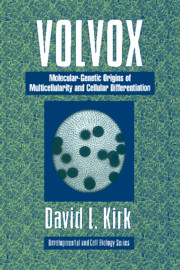 Volvox
Volvox Book contents
- Frontmatter
- Contents
- Preface
- Prologue
- 1 Introduction
- 2 The Volvocales: Many Multicellular Innovations
- 3 Ecological Factors Fostering the Evolution of Volvox
- 4 Cytological Features Fostering the Evolution of Volvox
- 5 Volvox carteri: A Rosetta Stone for Deciphering the Origins of Cytodifferentiation
- 6 Mutational Analysis of the V. carteri Developmental Program
- 7 Molecular Analysis of V. carteri Genes and Development
- Epilogue
- References
- Index
2 - The Volvocales: Many Multicellular Innovations
Published online by Cambridge University Press: 16 December 2009
- Frontmatter
- Contents
- Preface
- Prologue
- 1 Introduction
- 2 The Volvocales: Many Multicellular Innovations
- 3 Ecological Factors Fostering the Evolution of Volvox
- 4 Cytological Features Fostering the Evolution of Volvox
- 5 Volvox carteri: A Rosetta Stone for Deciphering the Origins of Cytodifferentiation
- 6 Mutational Analysis of the V. carteri Developmental Program
- 7 Molecular Analysis of V. carteri Genes and Development
- Epilogue
- References
- Index
Summary
Few groups of organisms hold such a fascination for evolutionary biologists as the Volvocales. It is almost as if these algae were designed to exemplify the process of evolution. They. … display, within a narrow taxonomic compass, extremes of somatic and sexual organization which could normally be found only in entirely unrelated groups: their somatic organization may be unicellular at one extreme, or multicellular with a macroscopic, functionally differentiated … body at the other; their sexual reproduction may be isogametic, with no distinction of male and female, … [or] oogametic, with a massive immotile ovum and a tiny motile sperm. These algae, therefore offer an unparalleled opportunity to describe and interpret the evolution of fundamental features of biological organization.
Bell (1985)The Volvocales discussed in that quotation are a subset of the green algae, or Chlorophyta, the most diverse and ubiquitous group of modern eukaryotic algae. Chlorophytes are characterized by a number of shared features, such as chloroplasts that contain chlorophylls a and b and are enclosed in a double membrane, the presence of certain characteristic carotenoids and xanthophylls, the ability to store excess photosynthate as starch, and so forth (Pickett-Heaps 1975; Mattox & Stewart 1984; Bold & Wynne 1985; Melkonian 1990). Many of those features are shared, of course, by a large and conspicuous set of descendants of the green algae: the vascular plants. To put the origins of Volvox in context, it will be useful to review briefly some of the major evolutionary trends that are evident when the green algae are viewed in a broad framework.
- Type
- Chapter
- Information
- VolvoxA Search for the Molecular and Genetic Origins of Multicellularity and Cellular Differentiation, pp. 16 - 44Publisher: Cambridge University PressPrint publication year: 1997


